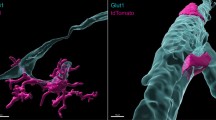Abstract
Confocal laser scanning microscopy (CLSM) was used to quantify and visualize the transport of the octapeptide and somatostatin analogue, octreotide (SMS 201-995, Sandostatin), across monolayers of bovine cerebrovascular endothelial cells, an in vitro model of the blood–brain barrier. The concentrations of octreotide and its conjugates in the cell culture medium were determined by radioimmunoassay (RIA). Two fluorescent conjugates of octreotide (FITC- and NBD-octreotide) were used to obtain CLSM images. The peptides did not undergo significant degradation in the presence of brain endothelial cell monolayers. The transport rate of octreotide expressed as clearance (Cl) and endothelial permeability (P e) did not depend on either the initial concentration (between 10 nM and 1 µM) or the site of administration (luminal or abluminal side of the mono-layer), indicating the absence of saturable and/or asymmetrical transport mechanisms. The P e of octreotide and that of the paracellular permeability marker fluorescein correlated well. Although the conjugates are more lipophilic than octreotide itself, they exhibited lower Cl and P e, values probably because of their larger molecular size. On the CLSM images, FITC-octreotide was present only in the intercellular space, while the cells did not exhibit detectable fluorescence. Transport studies and CLSM images suggest that octreotide passes the endothelial monolayer primarily via the paracellular route without significant contribution of carrier-mediated transport.
Similar content being viewed by others
REFERENCES
K. L. Audus, R. L. Bartel, I. J. Hidalgo, and R. T. Borchardt. The use of cultured epithelial and endothelial cells for drug transport and metabolism studies. Pharm. Res. 7:435–451 (1990).
W. M. Pardridge, D. Triguero, J. Yang, and P. A. Cancilla. Comparison of in vitro and in vivo models of drug transcytosis through the blood-brain barrier. J. Pharmacol. Exp. Ther. 253:884–891 (1990).
D. M. Shotton. Confocal scanning optical microscopy and its applications for biological specimens. J. Cell Sci. 94:175–206 (1989).
Y. Rojanasakul, S. W. Paddock, and J. R. Robinson. Confocal laser scanning microscopic examination of transport pathways and barriers of some peptides across the cornea. Int. J. Pharm. 61:163–172 (1990).
K. L. Audus and R. T. Borchardt. Characterization of an in vitro blood-brain barrier model system for studying drug transport and metabolism. Pharm. Res. 3:81–87 (1986).
J. B. M. M. van Bree, A. G. de Boer, M. Danhof, L. A. Ginsel, and D. D. Breimer. Characterization of an in vitro blood-brain barrier: Effects of molecular size and lipophilicity on cerebrovascular endothelial transport rates of drugs. J. Pharmacol. Exp. Ther. 247:1233–1239 (1988).
W. M. Pardridge. Peptide Drug Delivery to the Brain, Raven Press, New York, 1991.
J. B. M. M. van Bree, A. G. de Boer, J. Verhoef, M. Danhof, and D. D. Breimer. Peptide transport across the blood-brain barrier. J. Control. Release 13:175–184 (1990).
W. A. Banks, A. J. Kastin, and C. M. Barrera. Delivering peptides to the central nervous system: Dilemmas and strategies. Pharm. Res. 8:1345–1350 (1991).
P. E. Battershill and S. P. Clissold. Octreotide. A review of its pharmacodynamic and pharmacokinetic properties, and therapeutic potential in conditions associated with excessive peptide secretion. Drugs 38:658–702 (1989).
M. Lemaire, M. Azria, R. Dannecker, P. Marbach, A. Schweitzer, and G. Maurer. Disposition of sandostatin, a new synthetic somatostatin analogue, in rats. Drug Metab. Dispos. 17:699–703 (1989).
A. G. Harris. Future medical prospects for sandostatin. Metabolism 39(Suppl. 2):180–185 (1990).
B. M. Evers, D. Parekh, C. M. Townsend, and J. C. Thompson. Somatostatin and analogues in the treatment of cancer. Ann. Surg. 213:190–198 (1991).
J. C. Reubi, W. Lang, R. Maurer, J. W. Koper, and S. W. J. Lamberts. Distribution and biochemical characterization of somatostatin receptors in tumors of the human central nervous system. Cancer Res. 47:4758–5764 (1987).
G. Fricker, C. Bruns, J. Munzer, U. Briner, R. Albert, T. Kissel, and J. Vonderscher. Intestinal absorption of the octapeptide SMS 201-995 visualized by fluorescence derivatization. Gastroenterology 100:1544–1552 (1991).
W. Bauer, U. Briner, W. Doepfner, R. Haller, R. Huguenin, P. Marbach, T. J. Petcher, and J. Pless. SMS 201-995: A very potent and selective octapeptide analogue of somatostatin with prolonged action. Life Sci. 31:1133–1140 (1982).
J. N. Cogburn, M. G. Donovan, and C. S. Schasteen. A Model of human small intestinal absorptive cells. 1. Transport barrier. Pharm. Res. 8:210–216 (1991).
W. A. Banks, A. V. Schally, C. M. Barrera, M. B. Fasold, D. A. Durham, V. J. Csernus, K. Groot, and A. J. Kastin. Permeability of the murine blood-brain barrier to some octapeptide analogs of somatostatin. Proc. Natl. Acad. Sci. USA 87:6762–6766 (1990).
M. W. Bradbury. Transport across the blood-brain barrier. In E. A. Neuwelt (ed.), Implications of the Blood-Brain Barrier and Its Manipulation, Vol. 1. Basic Science Aspects, Plenum Medical Book, New York, 1989, pp. 119–136.
M. P. Dehouck, S. Méresse, P. Delorme, J. C. Fruchart, and R. Cecchelli. An easier, reproducible, and mass production method to study the blood-brain barrier in vitro. J. Neurochem. 54:1798–1801 (1990).
Author information
Authors and Affiliations
Rights and permissions
About this article
Cite this article
Jaehde, U., Masereeuw, R., De Boer, A.G. et al. Quantification and Visualization of the Transport of Octreotide, a Somatostatin Analogue, Across Monolayers of Cerebrovascular Endothelial Cells. Pharm Res 11, 442–448 (1994). https://doi.org/10.1023/A:1018929508018
Issue Date:
DOI: https://doi.org/10.1023/A:1018929508018




